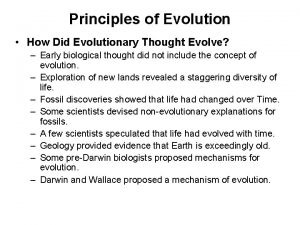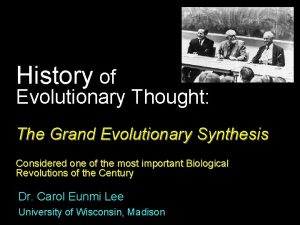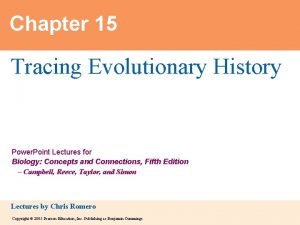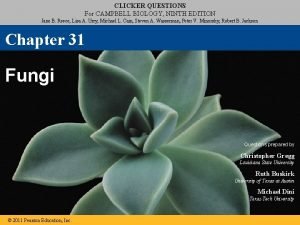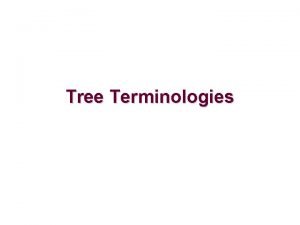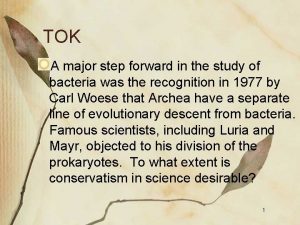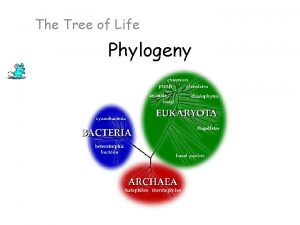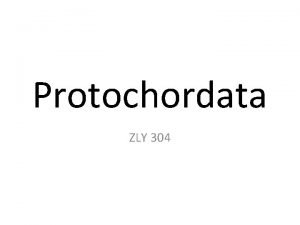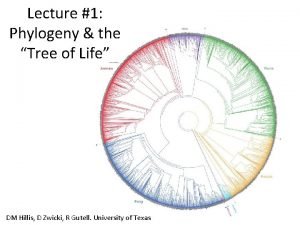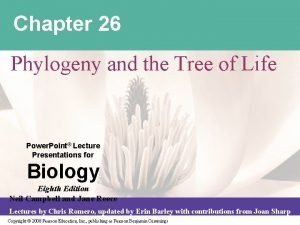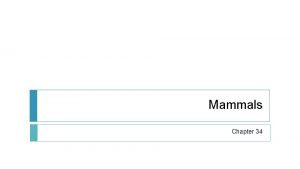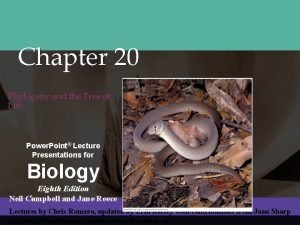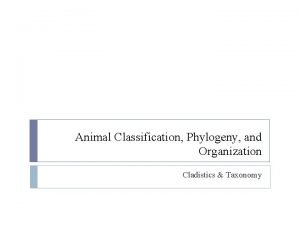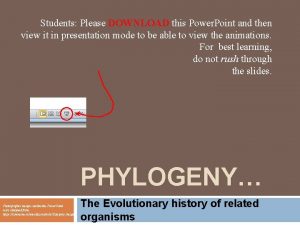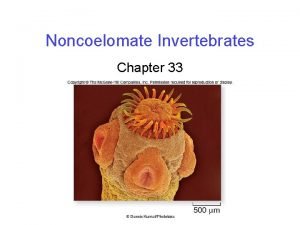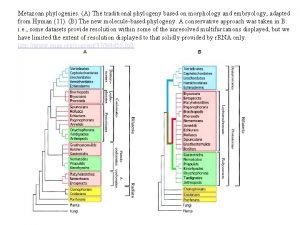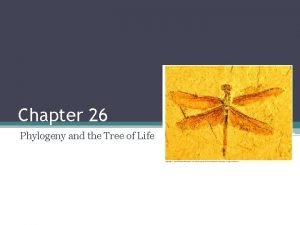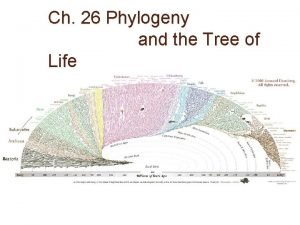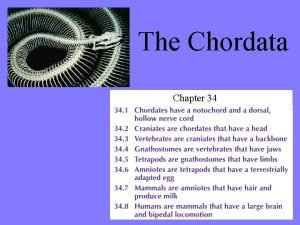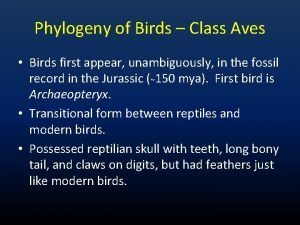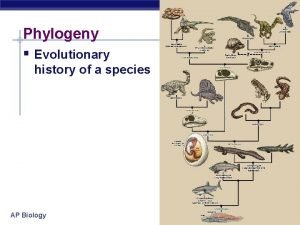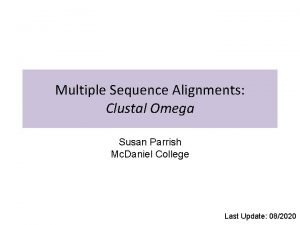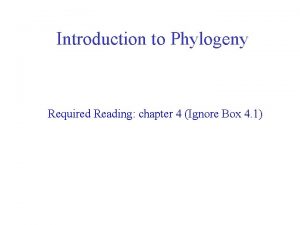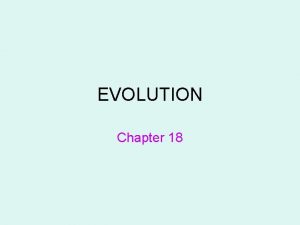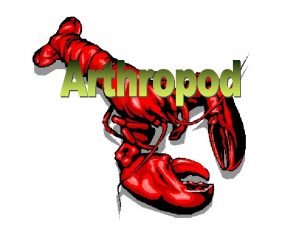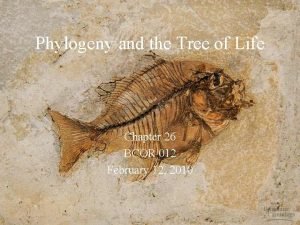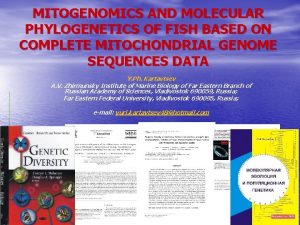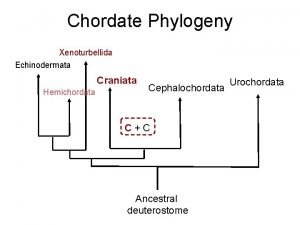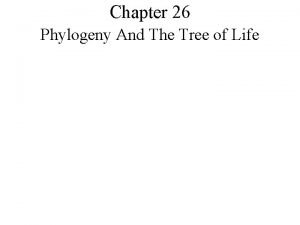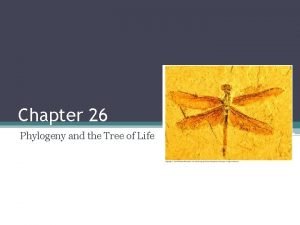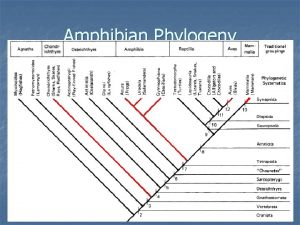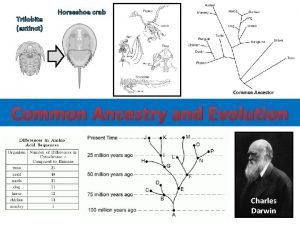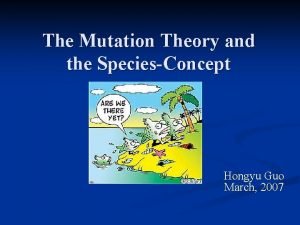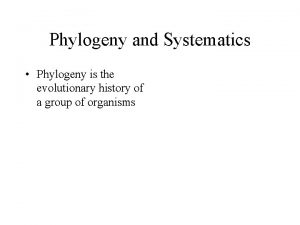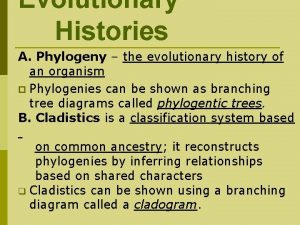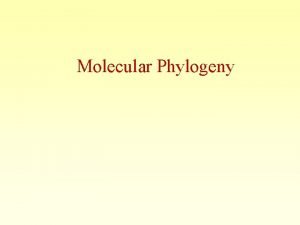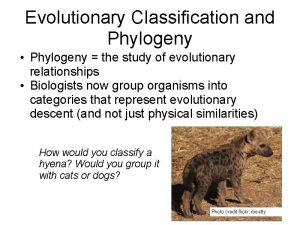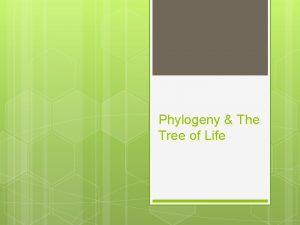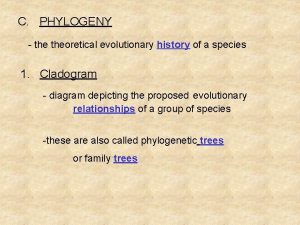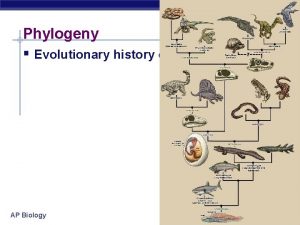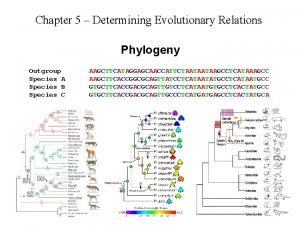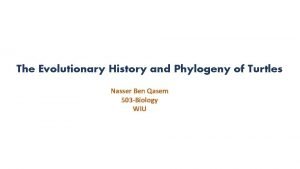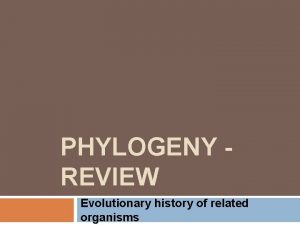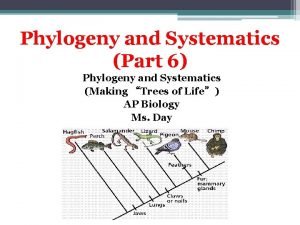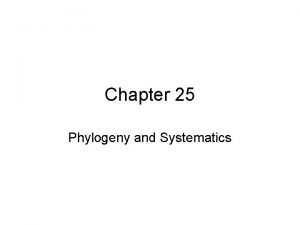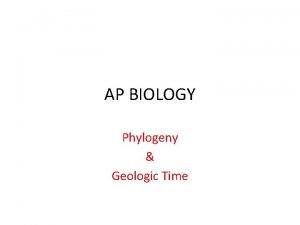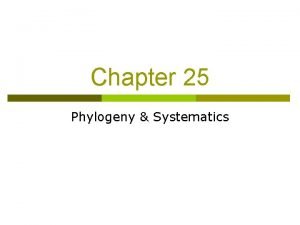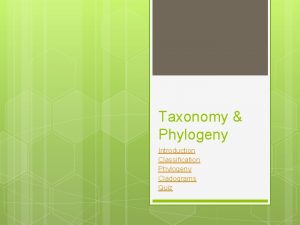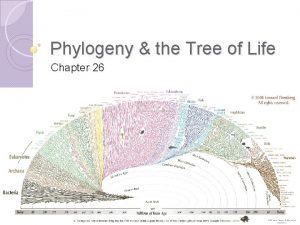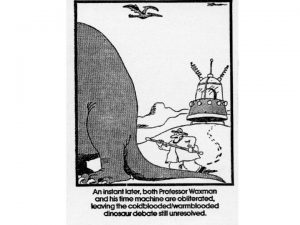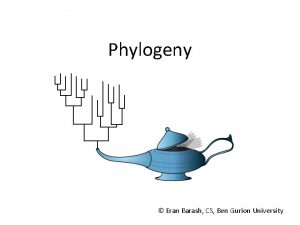Phylogeny is the evolutionary history of a species
















































































- Slides: 80

§ Phylogeny is the evolutionary history of a species or group of related species § For example, a phylogeny shows that legless lizards and snakes evolved from different lineages of legged lizards § The discipline of systematics classifies organisms and determines their evolutionary relationships © 2014 Pearson Education, Inc.

Figure 26. 2 Geckos ANCESTRAL LIZARD (with limbs) No limbs Snakes Iguanas Monitor lizard Eastern glass lizard No limbs © 2014 Pearson Education, Inc.

Concept 26. 1: Phylogenies show evolutionary relationships § Taxonomy is the scientific discipline concerned with classifying and naming organisms © 2014 Pearson Education, Inc.

Binomial Nomenclature § In the 18 th century, Carolus Linnaeus published a system of taxonomy based on resemblances § Two key features of his system remain useful today: two-part names for species and hierarchical classification © 2014 Pearson Education, Inc.

§ The two-part scientific name of a species is called a binomial § The first part of the name is the genus § The second part, called the specific epithet, is unique for each species within the genus § The first letter of the genus is capitalized, and the entire species name is italicized § Both parts together name the species (not the specific epithet alone) © 2014 Pearson Education, Inc.

Hierarchical Classification § Linnaeus introduced a system for grouping species in increasingly inclusive categories § The taxonomic groups from broad to narrow are domain, kingdom, phylum, class, order, family, genus, and species § A taxonomic unit at any level of hierarchy is called a taxon § The broader taxa are not comparable between lineages § For example, an order of snails has less genetic diversity than an order of mammals © 2014 Pearson Education, Inc.

Figure 26. 3 Cell division error Species: Panthera pardus Genus: Panthera Family: Felidae Order: Carnivora Class: Mammalia Phylum: Chordata Domain: Bacteria Kingdom: Animalia Domain: Eukarya © 2014 Pearson Education, Inc. Domain: Archaea

Linking Classification and Phylogeny § The evolutionary history of a group of organisms can be represented in a branching phylogenetic tree © 2014 Pearson Education, Inc.

Figure 26. 4 Order Family Genus Panthera Felidae Panthera pardus (leopard) Taxidea Lutra Mustelidae Carnivora Taxidea taxus (American badger) Lutra lutra (European otter) 1 Canis Canidae © 2014 Pearson Education, Inc. Species 2 Canis latrans (coyote) Canis lupus (gray wolf)

§ Linnaean classification and phylogeny can differ from each other § Systematists have proposed a classification system that would recognize only groups that include a common ancestor and all its descendants © 2014 Pearson Education, Inc.

§ A phylogenetic tree represents a hypothesis about evolutionary relationships § Each branch point represents the divergence of two species § Tree branches can be rotated around a branch point without changing the evolutionary relationships § Sister taxa are groups that share an immediate common ancestor © 2014 Pearson Education, Inc.

§ A rooted tree includes a branch to represent the last common ancestor of all taxa in the tree § A basal taxon diverges early in the history of a group and originates near the common ancestor of the group § A polytomy is a branch from which more than two groups emerge © 2014 Pearson Education, Inc.

Figure 26. 5 Branch point: where lineages diverge Taxon A 3 Taxon B 4 Taxon C Sister taxa 2 Taxon D ANCESTRAL LINEAGE 1 5 Taxon E Taxon F Taxon G This branch point represents the common ancestor of taxa A–G. © 2014 Pearson Education, Inc. This branch point forms a polytomy: an unresolved pattern of divergence. Basal taxon

What We Can and Cannot Learn from Phylogenetic Trees § Phylogenetic trees show patterns of descent, not phenotypic similarity § Phylogenetic trees do not indicate when species evolved or how much change occurred in a lineage § It should not be assumed that a taxon evolved from the taxon next to it © 2014 Pearson Education, Inc.

Applying Phylogenies § Phylogeny provides important information about similar characteristics in closely related species § A phylogeny was used to identify the species of whale from which “whale meat” originated © 2014 Pearson Education, Inc.

Figure 26. 6 Results Minke (Southern Hemisphere) Unknowns #1 a, 2, 3, 4, 5, 6, 7, 8 Minke (North Atlantic) Unknown #9 Humpback Unknown #1 b Blue Unknowns #10, 11, 12, 13 Fin © 2014 Pearson Education, Inc.

Concept 26. 2: Phylogenies are inferred from morphological and molecular data § To infer phylogenies, systematists gather information about morphologies, genes, and biochemistry of living organisms © 2014 Pearson Education, Inc.

Morphological and Molecular Homologies § Phenotypic and genetic similarities due to shared ancestry are called homologies § Organisms with similar morphologies or DNA sequences are likely to be more closely related than organisms with different structures or sequences © 2014 Pearson Education, Inc.

Sorting Homology from Analogy § When constructing a phylogeny, systematists need to distinguish whether a similarity is the result of homology or analogy § Homology is similarity due to shared ancestry § Analogy is similarity due to convergent evolution © 2014 Pearson Education, Inc.

§ Convergent evolution occurs when similar environmental pressures and natural selection produce similar (analogous) adaptations in organisms from different evolutionary lineages © 2014 Pearson Education, Inc.

Figure 26. 7 Australian marsupial “mole” North American eutherian mole © 2014 Pearson Education, Inc.

§ Bat and bird wings are homologous as forelimbs, but analogous as functional wings § Analogous structures or molecular sequences that evolved independently are also called homoplasies § Homology can be distinguished from analogy by comparing fossil evidence and the degree of complexity § The more elements that are similar in two complex structures, the more likely it is that they are homologous © 2014 Pearson Education, Inc.

Evaluating Molecular Homologies § Systematists use computer programs and mathematical tools when analyzing comparable DNA segments from different organisms © 2014 Pearson Education, Inc.

Figure 26. 8 -4 Cell division 2 CCATCA GAGT CC error 1 CCA T CAGAG T CC Deletion 1 CCA T CAGAG T CC 2 CCA T CAGAG T CC G T A Insertion 1 CCA T CAAGT CC 2 CCA TGTA CAG AGT CC 1 CCAT CA AGT CC 2 CCA TGTA CAG AGT CC © 2014 Pearson Education, Inc.

§ It is also important to distinguish homology from analogy in molecular similarities § Mathematical tools help to identify molecular homoplasies, or coincidences © 2014 Pearson Education, Inc.

Figure 26. 9 A CGGA T AG T CC A C T AGGC AC T A T C A CCG AC AGG T C T T T G A C T AG © 2014 Pearson Education, Inc.

Concept 26. 3: Shared characters are used to construct phylogenetic trees § Once homologous characters have been identified, they can be used to infer a phylogeny © 2014 Pearson Education, Inc.

Cladistics § Cladistics groups organisms by common descent § A clade is a group of species that includes an ancestral species and all its descendants § Clades can be nested in larger clades, but not all groupings of organisms qualify as clades © 2014 Pearson Education, Inc.

§ A valid clade is monophyletic, signifying that it consists of the ancestor species and all its descendants © 2014 Pearson Education, Inc.

Figure 26. 10 (a) Monophyletic group (clade) (b) Paraphyletic group A 1 A A B B C C C D D E E B F G © 2014 Pearson Education, Inc. (c) Polyphyletic group Group I 2 3 Group II D E F F G G Group III

Figure 26. 10 a (a) Monophyletic group (clade) A 1 B C D E F G © 2014 Pearson Education, Inc. Group I

Figure 26. 10 b (b) Paraphyletic group A B C D E 2 F G © 2014 Pearson Education, Inc. Group II

Figure 26. 10 c (c) Polyphyletic group A B C 3 D E F G © 2014 Pearson Education, Inc. Group III

§ A paraphyletic grouping consists of an ancestral species and some, but not all, of the descendants § A polyphyletic grouping includes distantly related species but does not include their most recent common ancestor © 2014 Pearson Education, Inc.

§ Polyphyletic groups are distinguished from paraphyletic groups by the fact that they do not include the most recent common ancestor § Biologists avoid defining polyphyletic groups and instead reclassify organisms if evidence suggests they are polyphyletic © 2014 Pearson Education, Inc.

Figure 26. 11 Common ancestor of even-toed ungulates Paraphyletic group Other even-toed ungulates Hippopotamuses Cetaceans Seals Bears Polyphyletic group © 2014 Pearson Education, Inc. Other carnivores

Shared Ancestral and Shared Derived Characters § In comparison with its ancestor, an organism has both shared and different characteristics § A shared ancestral character is a character that originated in an ancestor of the taxon § A shared derived character is an evolutionary novelty unique to a particular clade § A character can be both ancestral and derived, depending on the context © 2014 Pearson Education, Inc.

Inferring Phylogenies Using Derived Characters § When inferring evolutionary relationships, it is useful to know in which clade a shared derived character first appeared © 2014 Pearson Education, Inc.

Figure 26. 12 CHARACTERS TAXA Lancelet (outgroup) Lamprey Bass Frog Turtle Leopard Lancelet (outgroup) 0 1 1 1 Vertebral column (backbone) Hinged jaws 0 0 1 1 Four walking legs 0 0 0 1 1 1 Amnion 0 0 1 1 Hair 0 0 0 1 Lamprey Bass Vertebral column Frog Hinged jaws Turtle Four walking legs Amnion Leopard Hair (a) Character table © 2014 Pearson Education, Inc. (b) Phylogenetic tree

Figure 26. 12 a Lancelet (outgroup) Lamprey Bass Frog Turtle Leopard CHARACTERS TAXA 0 1 1 1 0 0 1 1 Four walking legs 0 0 0 1 1 1 Amnion 0 0 1 1 Hair 0 0 0 1 Vertebral column (backbone) Hinged jaws (a) Character table © 2014 Pearson Education, Inc.

Figure 26. 12 b Lancelet (outgroup) Lamprey Bass Vertebral column Frog Hinged jaws Turtle Four walking legs Amnion Leopard Hair (b) Phylogenetic tree © 2014 Pearson Education, Inc.

§ An outgroup is a species or group of species that is closely related to the ingroup, the various species being studied § The outgroup is a group that has diverged before the ingroup § Systematists compare each ingroup species with the outgroup to differentiate between shared derived and shared ancestral characteristics © 2014 Pearson Education, Inc.

§ Characters shared by the outgroup and ingroup are ancestral characters that predate the divergence of both groups from a common ancestor © 2014 Pearson Education, Inc.

Phylogenetic Trees with Proportional Branch Lengths § In some trees, the length of a branch can reflect the number of genetic changes that have taken place in a particular DNA sequence in that lineage § In other trees, branch length can represent chronological time, and branching points can be determined from the fossil record © 2014 Pearson Education, Inc.

Figure 26. 13 Drosophila Lancelet Zebrafish Frog Chicken Human Mouse © 2014 Pearson Education, Inc.

Figure 26. 14 Drosophila Lancelet Zebrafish Frog Chicken Human Mouse PALEOZOIC 542 © 2014 Pearson Education, Inc. MESOZOIC 251 Millions of years ago CENOZOIC 65. 5 Present

Maximum Parsimony and Maximum Likelihood § Systematists can never be sure of finding the best tree in a large data set § They narrow possibilities by applying the principles of maximum parsimony and maximum likelihood © 2014 Pearson Education, Inc.

§ Maximum parsimony assumes that the tree that requires the fewest evolutionary events (appearances of shared derived characters) is the most likely § The principle of maximum likelihood states that, given certain rules about how DNA changes over time, a tree can be found that reflects the most likely sequence of evolutionary events § Computer programs are used to search for trees that are parsimonious and likely © 2014 Pearson Education, Inc.

Figure 26. 15 Technique 3 1/C II III 1/C II I 1/C Species I 1 Species III Three phylogenetic hypotheses: I I III II II I 1 Site 2 3 4 Species I C T A T Species II C T T Species III Ancestral sequence A G 2 © 2014 Pearson Education, Inc. 1/C 4 3/A 2/T I 2/T 3/A II III 3/A 4/C III II III 2/T 4/C Results I II I 2/T 3/A 2/T 4/C I I III C II II A C III II I T T 6 events 7 events

Figure 26. 15 a Technique Species I 1 © 2014 Pearson Education, Inc. Species III Three phylogenetic hypotheses: I I III II II I

Figure 26. 15 b Technique 1 Site 3 2 4 Species I C T A T Species II C T T C Species III Ancestral sequence A G A C A G T T 2 © 2014 Pearson Education, Inc.

Figure 26. 15 c Technique 3 1/C II I III II 1/C II I 1/C 4 3/A 2/T I 2/T 3/A II 3/A 4/C 2/T II 2/T 4/C III III © 2014 Pearson Education, Inc. I 4/C 3/A 4/C 1/C I 2/T 3/A

Figure 26. 15 d Results I I III II II I 6 events © 2014 Pearson Education, Inc. 7 events

Phylogenetic Trees as Hypotheses § The best hypotheses for phylogenetic trees fit the most data: morphological, molecular, and fossil § Phylogenetic bracketing allows us to predict features of an ancestor from features of its descendants § For example, phylogenetic bracketing allows us to infer characteristics of dinosaurs © 2014 Pearson Education, Inc.

Figure 26. 16 Lizards and snakes Crocodilians Common ancestor of crocodilians, dinosaurs, and birds Ornithischian dinosaurs Saurischian dinosaurs Birds © 2014 Pearson Education, Inc.

§ Birds and crocodiles share several features: fourchambered hearts, song, nest building, and brooding § These characteristics likely evolved in a common ancestor and were shared by all of its descendants, including dinosaurs § The fossil record supports nest building and brooding in dinosaurs © 2014 Pearson Education, Inc.

Figure 26. 17 Front limb Hind limb Eggs (a) Fossil remains of Oviraptor and eggs © 2014 Pearson Education, Inc. (b) Artist’s reconstruction of the dinosaur’s posture based on the fossil findings

Concept 26. 4: An organism’s evolutionary history is documented in its genome § Comparing nucleic acids or other molecules to infer relatedness is a valuable approach for tracing organisms’ evolutionary history § DNA that codes for r. RNA changes relatively slowly and is useful for investigating branching points hundreds of millions of years ago § mt. DNA evolves rapidly and can be used to explore recent evolutionary events © 2014 Pearson Education, Inc.

Gene Duplications and Gene Families § Gene duplication increases the number of genes in the genome, providing more opportunities for evolutionary changes § Repeated gene duplications result in gene families § Like homologous genes, duplicated genes can be traced to a common ancestor © 2014 Pearson Education, Inc.

§ Orthologous genes are found in a single copy in the genome and are homologous between species § They can diverge only after speciation occurs © 2014 Pearson Education, Inc.

Figure 26. 18 (a) Formation of orthologous genes: a product of speciation (b) Formation of paralogous genes: within a species Ancestral gene Ancestral species Species C Speciation with divergence of gene Gene duplication and divergence Orthologous genes Species A Species B Paralogous genes Species C after many generations © 2014 Pearson Education, Inc.

§ Paralogous genes result from gene duplication, so are found in more than one copy in the genome § They can diverge within the clade that carries them and often evolve new functions © 2014 Pearson Education, Inc.

Genome Evolution § Orthologous genes are widespread and extend across many widely varied species § For example, humans and mice diverged about 65 million years ago, and 99% of our genes are orthologous © 2014 Pearson Education, Inc.

§ Gene number and the complexity of an organism are not strongly linked § For example, humans have only four times as many genes as yeast, a single-celled eukaryote § Genes in complex organisms appear to be very versatile, and each gene can encode multiple proteins that perform many different functions © 2014 Pearson Education, Inc.

Concept 26. 5: Molecular clocks help track evolutionary time § To extend phylogenies beyond the fossil record, we must make an assumption about how molecular change occurs over time © 2014 Pearson Education, Inc.

Molecular Clocks § A molecular clock uses constant rates of evolution in some genes to estimate the absolute time of evolutionary change § In orthologous genes, nucleotide substitutions are assumed to be proportional to the time since they last shared a common ancestor § In paralogous genes, nucleotide substitutions are proportional to the time since the genes became duplicated © 2014 Pearson Education, Inc.

§ Molecular clocks are calibrated against branches whose dates are known from the fossil record § Individual genes vary in how clocklike they are © 2014 Pearson Education, Inc.

Number of mutations Figure 26. 19 90 60 30 0 0 © 2014 Pearson Education, Inc. 60 90 30 Divergence time (millions of years) 120

Applying a Molecular Clock: Dating the Origin of HIV § Phylogenetic analysis shows that HIV is descended from viruses that infect chimpanzees and other primates § HIV spread to humans more than once § Comparison of HIV samples shows that the virus evolved in a very clocklike way © 2014 Pearson Education, Inc.

§ Application of a molecular clock to one strain of HIV suggests that strain spread to humans during the 1930 s § A more advanced molecular clock approach estimated the first spread to humans around 1910 © 2014 Pearson Education, Inc.

Figure 26. 20 Cell division error Index of base changes between HIV gene sequences 0. 20 0. 15 HIV 0. 10 Range Adjusted best-fit line (accounts for uncertain dates of HIV sequences) 0. 05 0 1900 © 2014 Pearson Education, Inc. 1920 1940 1960 Year 1980 2000

Concept 26. 6: Our understanding of the tree of life continues to change based on new data § Recently, we have gained insight into the very deepest branches of the tree of life through molecular systematics © 2014 Pearson Education, Inc.

From Two Kingdoms to Three Domains § Early taxonomists classified all species as either plants or animals § Later, five kingdoms were recognized: Monera (prokaryotes), Protista, Plantae, Fungi, and Animalia § More recently, the three-domain system has been adopted: Bacteria, Archaea, and Eukarya § The three-domain system is supported by data from many sequenced genomes © 2014 Pearson Education, Inc.

Figure 26. 21 Cell division error Euglenozoans Forams Diatoms Red algae Green algae Land plants Amoebas Domain Eukarya Ciliates Fungi Animals Methanogens COMMON ANCESTOR OF ALL LIFE Thermophiles Proteobacteria Chlamydias Spirochetes Gram-positive bacteria Cyanobacteria (Chloroplasts)* Domain Bacteria (Mitochondria)* © 2014 Pearson Education, Inc. Domain Archaea Nanoarchaeotes

The Important Role of Horizontal Gene Transfer § The tree of life suggests that eukaryotes and archaea are more closely related to each other than to bacteria § The tree of life is based largely on r. RNA genes; however, some other genes reveal different relationships © 2014 Pearson Education, Inc.

§ There have been substantial interchanges of genes between organisms in different domains § Horizontal gene transfer is the movement of genes from one genome to another § Horizontal gene transfer occurs by exchange of transposable elements and plasmids, viral infection, and fusion of organisms © 2014 Pearson Education, Inc.

§ Disparities between gene trees can be explained by the occurrence of horizontal gene transfer § Horizontal gene transfer has played a key role in the evolution of both prokaryotes and eukaryotes © 2014 Pearson Education, Inc.

Figure 26. 22 © 2014 Pearson Education, Inc.

§ Some biologists argue that horizontal gene transfer was so common that the early history of life should be represented as a tangled network of connected branches © 2014 Pearson Education, Inc.

Figure 26. 23 Domain Eukarya Thermophiles Proteobacteria © 2014 Pearson Education, Inc. Domain Bactera Cyanobacteria Domain Archaea Ancestral cell populations Methanogens
 Keystone species plants
Keystone species plants Ellis van creveld syndrome
Ellis van creveld syndrome History of evolutionary thought
History of evolutionary thought Chapter 15 tracing evolutionary history
Chapter 15 tracing evolutionary history Evolutionary history
Evolutionary history Polytomy definition
Polytomy definition Outgroup in phylogeny
Outgroup in phylogeny What is a sister group in phylogeny
What is a sister group in phylogeny Phylogenetic relationship of protochordates
Phylogenetic relationship of protochordates Crab cladogram
Crab cladogram Biology taxonomy tree
Biology taxonomy tree Polytomy
Polytomy Phylogeny and the tree of life chapter 26
Phylogeny and the tree of life chapter 26 Cladogram animal kingdom
Cladogram animal kingdom What is a mammal
What is a mammal Chapter 20 phylogeny and the tree of life
Chapter 20 phylogeny and the tree of life Symplesiomorphy vs synapomorphy
Symplesiomorphy vs synapomorphy Phylogeny
Phylogeny Phylum platyhelminthes
Phylum platyhelminthes Bryozoa
Bryozoa Monophyletic paraphyletic polyphyletic
Monophyletic paraphyletic polyphyletic Homologies
Homologies Chordate phylogeny
Chordate phylogeny Avian phylogeny
Avian phylogeny Cat family tree
Cat family tree Clustal w omega
Clustal w omega Deer family tree
Deer family tree Define descent with modification
Define descent with modification Closed circulatory system
Closed circulatory system Chapter 26 phylogeny and the tree of life
Chapter 26 phylogeny and the tree of life Fish phylogeny
Fish phylogeny Craniata phylogeny
Craniata phylogeny Phylogeny is the study of _____.
Phylogeny is the study of _____. Chapter 26 phylogeny and the tree of life
Chapter 26 phylogeny and the tree of life Conus arteriosus
Conus arteriosus Hình ảnh bộ gõ cơ thể búng tay
Hình ảnh bộ gõ cơ thể búng tay Bổ thể
Bổ thể Tỉ lệ cơ thể trẻ em
Tỉ lệ cơ thể trẻ em Gấu đi như thế nào
Gấu đi như thế nào Tư thế worms-breton
Tư thế worms-breton Bài hát chúa yêu trần thế alleluia
Bài hát chúa yêu trần thế alleluia Môn thể thao bắt đầu bằng chữ đua
Môn thể thao bắt đầu bằng chữ đua Thế nào là hệ số cao nhất
Thế nào là hệ số cao nhất Các châu lục và đại dương trên thế giới
Các châu lục và đại dương trên thế giới Cong thức tính động năng
Cong thức tính động năng Trời xanh đây là của chúng ta thể thơ
Trời xanh đây là của chúng ta thể thơ Mật thư tọa độ 5x5
Mật thư tọa độ 5x5 Làm thế nào để 102-1=99
Làm thế nào để 102-1=99 Phản ứng thế ankan
Phản ứng thế ankan Các châu lục và đại dương trên thế giới
Các châu lục và đại dương trên thế giới Thơ thất ngôn tứ tuyệt đường luật
Thơ thất ngôn tứ tuyệt đường luật Quá trình desamine hóa có thể tạo ra
Quá trình desamine hóa có thể tạo ra Một số thể thơ truyền thống
Một số thể thơ truyền thống Cái miệng xinh xinh thế chỉ nói điều hay thôi
Cái miệng xinh xinh thế chỉ nói điều hay thôi Vẽ hình chiếu vuông góc của vật thể sau
Vẽ hình chiếu vuông góc của vật thể sau Nguyên nhân của sự mỏi cơ sinh 8
Nguyên nhân của sự mỏi cơ sinh 8 đặc điểm cơ thể của người tối cổ
đặc điểm cơ thể của người tối cổ V. c c
V. c c Vẽ hình chiếu đứng bằng cạnh của vật thể
Vẽ hình chiếu đứng bằng cạnh của vật thể Tia chieu sa te
Tia chieu sa te Thẻ vin
Thẻ vin đại từ thay thế
đại từ thay thế điện thế nghỉ
điện thế nghỉ Tư thế ngồi viết
Tư thế ngồi viết Diễn thế sinh thái là
Diễn thế sinh thái là Dot
Dot Số nguyên tố là số gì
Số nguyên tố là số gì Tư thế ngồi viết
Tư thế ngồi viết Lời thề hippocrates
Lời thề hippocrates Thiếu nhi thế giới liên hoan
Thiếu nhi thế giới liên hoan ưu thế lai là gì
ưu thế lai là gì Hươu thường đẻ mỗi lứa mấy con
Hươu thường đẻ mỗi lứa mấy con Khi nào hổ con có thể sống độc lập
Khi nào hổ con có thể sống độc lập Hệ hô hấp
Hệ hô hấp Từ ngữ thể hiện lòng nhân hậu
Từ ngữ thể hiện lòng nhân hậu Thế nào là mạng điện lắp đặt kiểu nổi
Thế nào là mạng điện lắp đặt kiểu nổi Evolutionary perspective of psychology
Evolutionary perspective of psychology Evolutionary fuzzing
Evolutionary fuzzing Horseshoe crab trilobite
Horseshoe crab trilobite Modern evolutionary synthesis
Modern evolutionary synthesis

